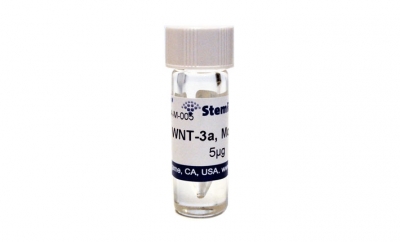| Source | M.W. | ~40 kDa | CAS No. | ||
|---|---|---|---|---|---|
| Structural Info | |||||
| Formulation | Lyophilized in sterile filtered solution of PBS with 1% CHAPS | ||||
| Reconstitution | Before reconstitution, we recommend a brief spin to drive down any material dislodged from the bottom of the tube. The lyophilized protein should be reconstituted in sterile H2O to a concentration of 100 ng/uL. Because of the hydrophobic nature of this protein, further dilutions should be made in buffer or medium containing carrier proteins, such as albumin or serum. | ||||
| Stability | The lyophilized protein is stable for at least 1 year if stored at -80 °C. Reconstituted protein is stable for at least 1 month at 4 °C, but should be stored in aliquots at -80 °C for longer term. Avoid repeated freeze and thaw. |
||||
| Purity | Greater than 90% as determined by SDS-PAGE analysis | ||||
| Biological Activity | The activity was determined by using a TCF reporter gene assay in NIH3T3 cells. The EC50 ranges from 50 - 150 ng/ml. | ||||
| Country of Origin | USA | ||||
WNT-3a is a member of the WNT family of signaling proteins that play a key role in embryonic development and the
integrity of adult tissues. WNT-3a is a prototypic canonical WNT that signals through the b-catenin pathway. The predicted size of mouse WNT-3a is a monomeric protein containing 333 amino acid residues. Due to glycosylation, it migrates at an
apparent molecular weight of 40 kDa by SDS-PAGE analysis under non-reducing conditions. StemRD’s product is expressed from a mouse cell line overexpressing mouse WNT-3a. Purification is performed with a proprietary process that is distinct from the published method.
Mae S, Shono A, Shiota F et al., Monitoring and robust induction of nephrogenic intermediate mesoderm from human pluripotent stem cells. Nature Communication. 2013;4:1367.
http://www.ncbi.nlm.nih.gov/pubmed/23340407
Chu, M. L. H., Ahn, V. E., Choi, H. J., et al., Structural Studies of Wnts and Identification of an LRP6 Binding Site. Structure., 2013
http://www.ncbi.nlm.nih.gov/pubmed/23791946
http://www.ncbi.nlm.nih.gov/pubmed/23340407
Chu, M. L. H., Ahn, V. E., Choi, H. J., et al., Structural Studies of Wnts and Identification of an LRP6 Binding Site. Structure., 2013
http://www.ncbi.nlm.nih.gov/pubmed/23791946
